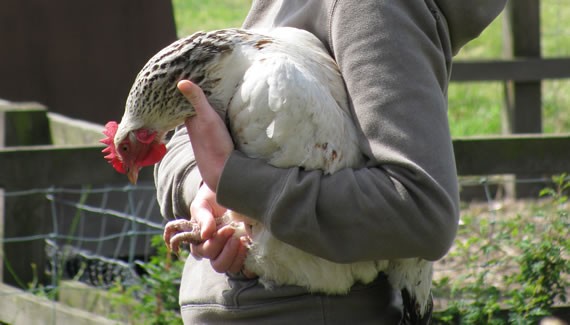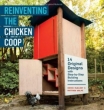Catching, handling and restraint
Birds for slaughter should be handled quietly and calmly, to prevent panic and distress, and possibly injury to both bird and handlers.
Birds should be caught in dim lighting conditions to reduce the risk of panic; once caught, they should be handled with care to avoid stress and bruising to the carcase. Birds should be picked up individually, with both wings restrained or, if that isn’t possible, by grasping both legs in one hand and supporting the breast in the other.
 Proper handling doesn't stress the bird or the handler
Proper handling doesn't stress the bird or the handler
Birds should be restrained during slaughter; this gives you both hands free and reduces fear in and risk of injury to the bird. After stunning and slaughter, there will be a fair amount of wing flapping and movement, which can damage the carcase, so is best avoided.
Any form of restraint should commence immediately before slaughter. For poultry, restraint may be manual but one of the most common forms of restraint is the cone; birds are inverted into the cone with the head lowered through the hole and slaughtered immediately.
We use an old traffic cone which has been cut to size, attached to a telegraph pole. This is large enough to accommodate the Hubbards we raise for meat, but when we have to cull laying hens, which are much smaller than the meat chickens, we insert a smaller cone into the large cone to prevent the bird slipping through.
- Previous « Slaughtering poultry
- Next Slaughter »

About Rosemary Champion
Rosemary lives on a 12 acre smallholding in Angus, in the east of Scotland, where she keeps Ryeland Sheep, Shetland cattle and assorted poultry. She was destined to be a smallholder from an early age.
Further Reading
 Chicken & Eggs: River Cottage Handbook No.11 Mark Diacono |  Storey's Guide to Raising Chickens Gail Damerow |  A Beginners Guide to Caring for Ex-Batts Jo Barlow |  Reinventing the Chicken Coop Matthew Wolpe |  Chickens: The Essential Guide to Choosing and Keeping Happy, Healthy Hens Suzie Baldwin |
Smallholding shop
When you click links below and make a purchase, this may result in this site earning a commission from eBay.

Pheasant Feeder 38cm
Eltex Pheasant Feeder.Holds up… from £40.08 + p&p

Super Poultry Drinker 2½li
Super Poultry Drinker.… from £6.96 + p&p

Natures Grub-Chicken Seed and Insect Mix 700g
A delectable mix of… from £6.38 + p&p

Poultry Leg Rings 16mm pk 100
Poultry Leg Rings 16mm Plastic… from £9.28 + p&p
















